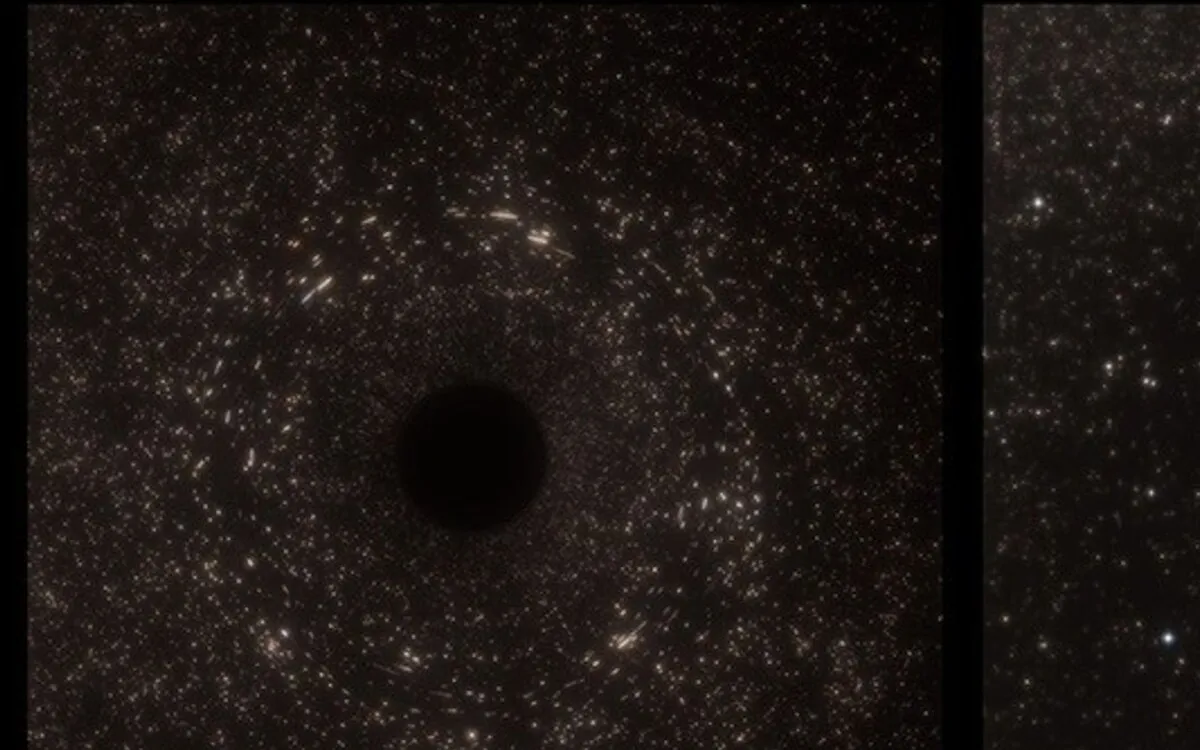
In a finding reminiscent of a science fiction narrative, astronomers utilizing NASA telescopes have uncovered a formidable presence known as 'Space Jaws.' This massive black hole resides a staggering 600 million light-years away, hidden in the dark void between stars, where it voraciously consumes any stray star that ventures too close. The elusive black hole revealed itself during a recently detected tidal disruption event (TDE), where a helpless star was torn apart and devoured in a dramatic explosion of radiation.
Tidal disruption events serve as powerful indicators of black hole behavior, shedding light on the conditions necessary for initiating jets and winds when a black hole engages in star consumption. These events are identified as bright signals by telescopes, allowing astronomers to study their characteristics. The new TDE, designated AT2024tvd, enabled scientists to locate this wandering supermassive black hole using the Hubble Space Telescope, with additional observations from NASA's Chandra X-ray Observatory and the NRAO Very Large Array telescope. Notably, this black hole is positioned away from the central region of its host galaxy.
Surprisingly, this 1-million-solar-mass black hole does not sit at the heart of its galaxy, where supermassive black holes typically reside. Instead, it is the first offset TDE identified among approximately 100 recorded events by optical sky surveys. Most TDEs are associated with central black holes. Interestingly, at the core of the host galaxy lies a different supermassive black hole, boasting a mass of 100 million times that of the Sun. The Hubble telescope revealed that the TDE occurred just 2,600 light-years from this more massive black hole, a distance merely one-tenth that between our Sun and the Milky Way's central supermassive black hole.
The larger black hole actively emits energy as it consumes surrounding gas, categorizing it as an active galactic nucleus. Remarkably, both supermassive black holes coexist within the same galaxy but are not gravitationally bound to each other as a binary system. There is potential for the smaller black hole to spiral into the galaxy's center and merge with the larger black hole in the future, but currently, they remain too distant to be gravitationally connected.
A tidal disruption event occurs when an incoming star is stretched, or 'spaghettified,' by the immense gravitational forces of a black hole. The remnants of the shredded star are pulled into orbit around the black hole, producing shocks and outflows that generate high-temperature emissions detectable in ultraviolet and visible light. AT2024tvd marks the first offset TDE captured by optical sky surveys, opening avenues to discover this elusive population of wandering black holes in future sky surveys, according to lead study author Yuhan Yao from the University of California at Berkeley.
The star-consuming black hole revealed its presence when ground-based sky survey telescopes detected a flare as bright as a supernova. However, unlike a supernova, astronomers identified this flare as originating from a black hole consuming a star, evidenced by its extreme heat and the broad emission lines of hydrogen, helium, carbon, nitrogen, and silicon. The Zwicky Transient Facility at Caltech's Palomar Observatory, equipped with a 1.2-meter telescope that surveys the northern sky every two days, was the first to observe this event.
According to Ryan Chornock, an associate adjunct professor at UC Berkeley and a member of the ZTF team, tidal disruption events hold immense potential for revealing the presence of massive black holes that would otherwise remain undetected. Theoretical predictions have long suggested that a population of massive black holes exists away from galaxy centers, and TDEs can now help locate them.
The flare appeared to be misaligned with the center of a bright massive galaxy as cataloged by various surveys, including Pan-STARRS, Sloan Digital Sky Survey, and the DESI Legacy Imaging Survey. To ascertain that the flare was indeed offset from the galactic center, Yao's team employed NASA's Chandra X-ray Observatory to confirm that the X-rays from the flare were also misaligned. The unparalleled resolution of Hubble was crucial in resolving any uncertainties regarding the location of the TDE, which emitted light significantly bluer than the rest of the galaxy.
The black hole responsible for the TDE lurks within the bulge of its massive galaxy, only revealing itself every few tens of thousands of years when it captures a star. How did this black hole end up off-center? Previous theoretical studies indicate that black holes can be ejected from galaxy centers due to three-body interactions, where a less massive black hole is expelled. This scenario might apply here, given the proximity of the stealthy black hole to the central black hole.
Another hypothesis suggests that this black hole could be a surviving remnant from a smaller galaxy that merged with the host galaxy over a billion years ago. If this is the case, the black hole may eventually spiral in to merge with the central active black hole far into the future. Currently, astronomers are uncertain about its trajectory. Erica Hammerstein, a postdoctoral researcher at UC Berkeley, examined the Hubble images as part of the study but found no evidence of a prior galaxy merger. She noted, "While there is strong evidence that galaxy mergers enhance TDE rates, the presence of a second black hole in the host galaxy indicates that a merger must have occurred in the galaxy's past."